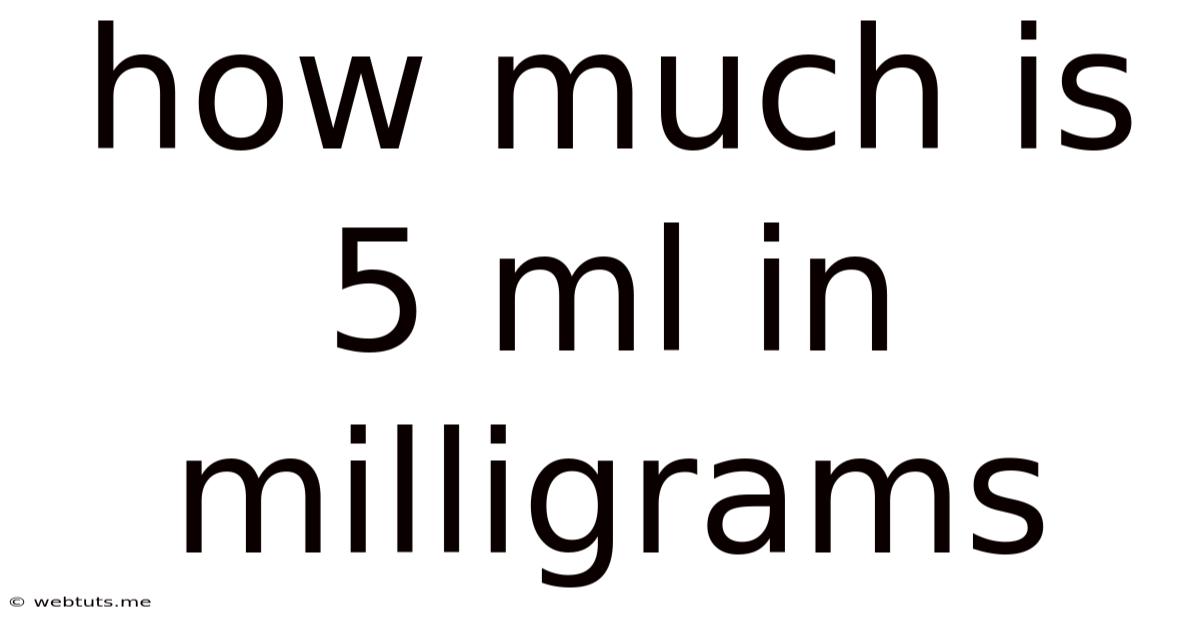How Much Is 5 Ml In Milligrams
Webtuts
May 09, 2025 · 4 min read

Table of Contents
How Much is 5 ml in Milligrams? Understanding Volume vs. Mass
The question "How much is 5 ml in milligrams?" is a common one, but it doesn't have a single, straightforward answer. This is because milliliters (ml) and milligrams (mg) measure different properties: milliliters measure volume, while milligrams measure mass (or weight). To convert between them, you need to know the density of the substance you're measuring. Density is the mass per unit volume, often expressed as grams per milliliter (g/ml) or kilograms per liter (kg/l).
This article will delve into the complexities of this conversion, explaining the relationship between volume and mass, providing examples with various substances, and offering a clear understanding of why a simple conversion factor doesn't exist.
The Crucial Role of Density
Density is the key to understanding the relationship between volume (ml) and mass (mg). Different substances have different densities. For example, a milliliter of water weighs significantly less than a milliliter of mercury. The density of water is approximately 1 g/ml (or 1000 mg/ml), while the density of mercury is around 13.6 g/ml (or 13600 mg/ml).
This means that 5 ml of water would have a mass of approximately 5000 mg (5 g), while 5 ml of mercury would have a mass of approximately 68000 mg (68 g). See the difference? The volume is the same, but the mass varies drastically depending on the density.
Calculating Mass from Volume and Density
The formula to calculate mass from volume and density is:
Mass (mg) = Volume (ml) × Density (mg/ml)
Let's break down how to use this formula with different examples:
Example 1: Water
- Volume: 5 ml
- Density of Water: 1000 mg/ml (approximately)
- Calculation: 5 ml × 1000 mg/ml = 5000 mg
Therefore, 5 ml of water weighs approximately 5000 mg (or 5 grams).
Example 2: Mercury
- Volume: 5 ml
- Density of Mercury: 13600 mg/ml (approximately)
- Calculation: 5 ml × 13600 mg/ml = 68000 mg
Therefore, 5 ml of mercury weighs approximately 68000 mg (or 68 grams).
Example 3: Ethanol (Alcohol)
- Volume: 5 ml
- Density of Ethanol: 789 mg/ml (approximately)
- Calculation: 5 ml × 789 mg/ml = 3945 mg
Therefore, 5 ml of ethanol weighs approximately 3945 mg (or 3.945 grams).
The Importance of Precise Density Values
The examples above used approximate density values. For accurate conversions, you need to use the most precise density value possible for the specific substance at a given temperature and pressure. Density can vary slightly depending on these conditions. You can often find accurate density values in scientific literature, chemical handbooks, or online databases.
Beyond Liquids: Solids and Gases
The concept of density and its role in converting volume to mass applies to solids and gases as well, although the measurement methods might differ. For solids, you might use techniques like water displacement to determine volume, while for gases, you'd typically measure volume at a specific temperature and pressure and use the ideal gas law to estimate mass.
Common Mistakes to Avoid
- Assuming a universal conversion factor: There's no single conversion factor between ml and mg. Always remember to consider the density of the substance.
- Using inaccurate density values: Use the most precise density value available for your specific substance and conditions.
- Confusing volume and mass: Remember that milliliters measure volume (how much space something occupies), while milligrams measure mass (the amount of matter).
Practical Applications
Understanding the relationship between volume and mass is crucial in various fields:
- Chemistry: In chemical reactions, knowing the mass of reactants is essential for accurate stoichiometric calculations.
- Pharmacology: Dosage calculations often involve converting between volume and mass, especially when dealing with liquid medications.
- Food science: Determining the mass of ingredients in recipes sometimes requires converting from volume measurements.
- Engineering: Many engineering applications require precise mass calculations based on volume measurements of materials.
Conclusion: No Simple Answer, But a Clear Process
The question "How much is 5 ml in milligrams?" doesn't have a simple numerical answer. The conversion requires knowledge of the substance's density and the application of the formula: Mass (mg) = Volume (ml) × Density (mg/ml). By understanding this principle and using precise density values, you can accurately convert between volume and mass for any substance. Remember to always account for the specific density of the material you are working with, as this significantly impacts the final mass calculation. Accurate conversions are critical for many scientific, medical, and industrial applications. Therefore, careful attention to detail and the use of reliable density data are paramount for obtaining correct results. This detailed understanding allows for precise calculations and informed decision-making across various scientific and practical contexts.
Latest Posts
Latest Posts
-
How Many Days Till Febuary 21st
May 09, 2025
-
How Many Gallons In A Milliliter
May 09, 2025
-
How Many Days Till March 30 2024
May 09, 2025
-
What Is 19 In Decimal Form
May 09, 2025
-
40 Tablespoons Is How Many Cups
May 09, 2025
Related Post
Thank you for visiting our website which covers about How Much Is 5 Ml In Milligrams . We hope the information provided has been useful to you. Feel free to contact us if you have any questions or need further assistance. See you next time and don't miss to bookmark.